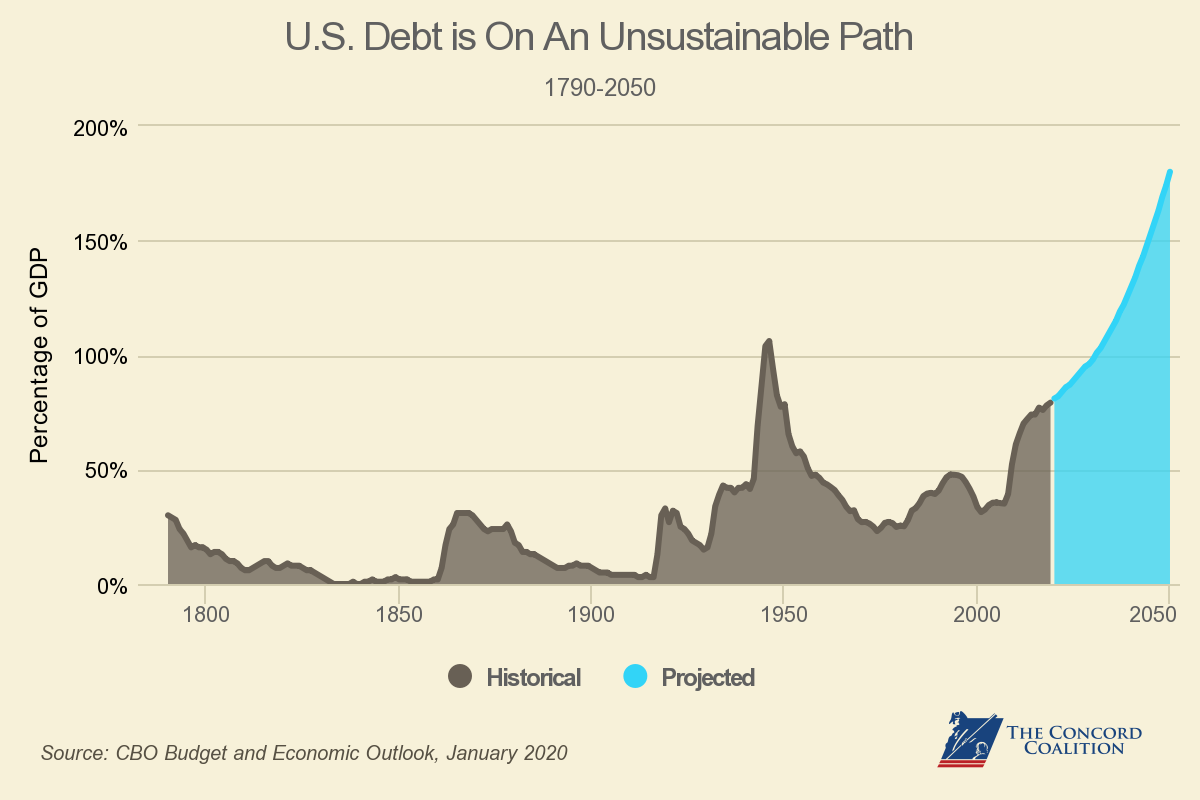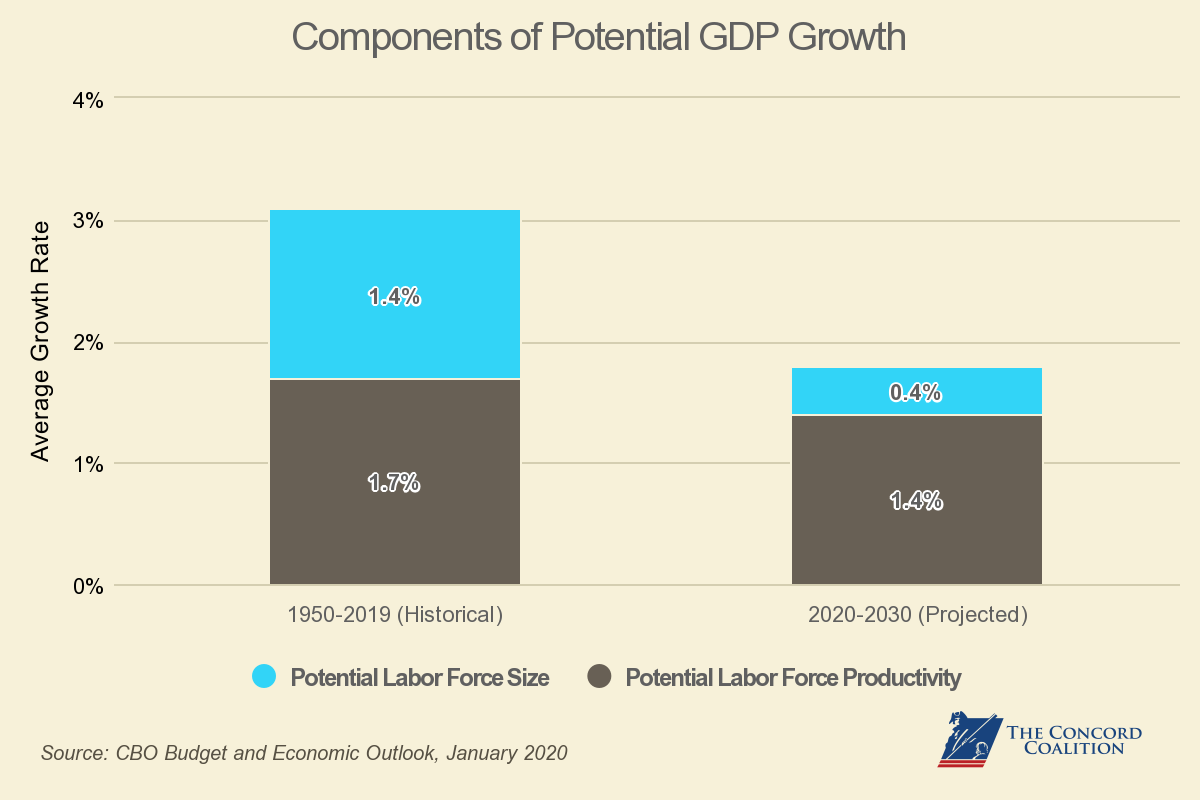The Concord Coalition said today that new Congressional Budget Office (CBO) projections showing federal deficits and debt steadily rising over the next 10 years and leaping to historic highs over the longer term are an alarming signal that action is required to put the budget on a more sustainable path.
“Today’s update from CBO provides a sobering reality check on campaign calls for major spending increases or big tax cuts,” said Robert L. Bixby, executive director of The Concord Coalition.
“The deteriorating budget outlook during a period of sustained economic growth and low unemployment reflects the continuing failure of elected officials in Washington to acknowledge that the federal budget is on a perilous path, much less do anything about it. At a time when we should be seeing budget deficits shrink, they are projected to average over $1.3 trillion annually for the next decade. Even if offsetting actions are taken to “pay for” new initiatives, keeping the debt from rising higher than current projections would do nothing to address the unsustainable path the budget is already on,” Bixby added.
According to CBO, this year’s deficit will be $1.0 trillion (4.6 percent of GDP). Over 10 years, cumulative deficits are projected to total $13.1 trillion with debt held by the public projected to grow from 82 percent of GDP to 98 percent. Today’s numbers might represent an optimistic scenario since they assume a revenue spike due to the scheduled expiration of tax cuts in 2025.
Most striking is CBO’s updated long-term outlook, which the agency describes as “daunting.” It projects that debt will reach 180 percent of GDP in 2050, roughly one- third higher than in the previous long-term outlook. Lower projected revenues, higher spending and slower economic growth combine to produce the more troubling picture beyond 2030.

Here are some 2020-2030 fiscal facts from CBO’s report that will confront those who are elected to federal office this November:
-
By 2030, the last year of CBO’s 10-year outlook, the deficit will be $1.7 trillion (5.4 percent of GDP).
-
Revenues will rise by $2.1 trillion, averaging 17.3 percent of GDP. Spending, however, will rise by $2.8 trillion, growing from 21.0 percent of GDP to 23.4 percent.
-
The federal government’s major health care programs will grow by 88 percent in dollar terms ($1.0 trillion) and by 1.6 percent of GDP.
-
Social Security will grow by 76 percent in dollar terms ($832 billion) and by 1.1 percent of GDP.
-
Interest on the debt will grow by 114 percent in dollar terms ($437 billion) and by 0.8 percent of GDP.
-
Mandatory spending — which grows on autopilot and includes the major entitlement programs — along with interest on the debt will consume 99.2 percent of all revenues by 2030.
Problems are apparent on both the spending and tax sides of the budget.
The big automatic spending programs — notably Social Security and Medicare — are growing rapidly because the aging population means large numbers of people are leaving the workforce each year and becoming eligible for government benefits. In addition, the continued rise of health care costs pushes this spending up further.
The existence of positive trust fund balances in Social Security and Medicare should not obscure the fact that their negative cash flows contribute to projected federal budget deficits. According to the CBO, the cash deficits for Social Security and Medicare will contribute 2.1 percent of GDP to the deficit in 2020 rising to 6.2 percent in the later years of the long-term outlook (2041-2050).
Discretionary spending — which includes defense, education, transportation, justice, environment and certain veterans’ benefits — will decline from 6.4 percent of GDP in 2020 to 5.6 percent in 2030. This would be the lowest level since record-keeping for this category began in 1962. The 50-year average for discretionary spending is 8.3 percent of GDP.
The contrast between the shrinking levels of discretionary spending and rising deficits is captured by the remarkable projection that in 2030 they will both amount to roughly $1.7 trillion. In other words, cutting “waste, fraud and abuse,” as so many candidates advocate, is not the answer; Congress would have to eliminate all discretionary spending to balance the budget that year (assuming there were no entitlement cuts or tax increases).
On the tax side, revenues have not gone up as much as would have been expected in a strong economy. If tax cuts are extended, instead of expiring in 2025, the CBO projects revenue will remain below the historical average (17.4 percent of GDP) over the coming 10 years.
While the economy is currently growing and the unemployment rate is low, the CBO report has some grim news for the future, with economic growth slowing from 2.4 percent in 2019 to 2.2 percent in 2020 and then averaging 1.7 percent through the rest of the decade. While some of that slowdown is because of the diminishing effect from the 2017 tax cut and increased spending, the primary culprits are structural: the aging population leading to a declining labor force, and a decline in labor productivity.

The CBO warns of the economic consequences of rising federal debt, saying that “To put debt on a sustainable path, lawmakers will have to make significant changes to tax and spending policies—increasing revenues more than they would under current law, reducing spending below projected amounts, or adopting some combination of those approaches.”
Bixby urged that “Policymakers and candidates should focus on fiscally responsible and credible solutions to these structural economic impediments. Tax cuts haven’t and won’t fix declines in labor force growth and productivity. Instead, fixing our immigration system has the potential to increase labor force growth while smarter and fiscally responsible investment, retirement and health care policies could help boost needed economic growth more generally. Ignoring these problems will not make them go away and will not build a political mandate for meaningful action. The longer we wait, the more difficult the solutions will be — and the greater the risks will be to the nation’s future.”




